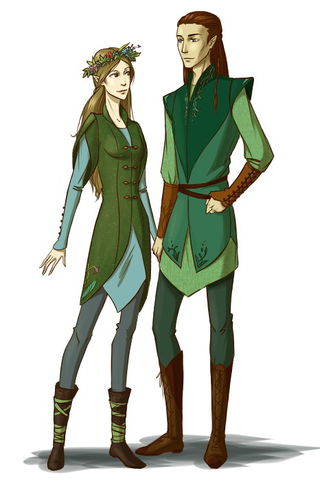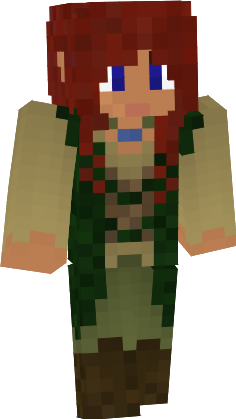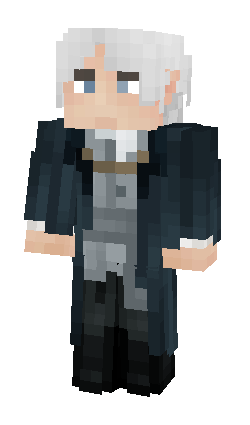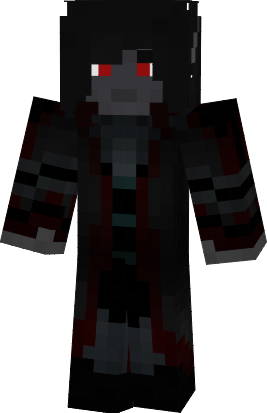Elves
|
The elves, known as Mali within the Elven language, are long-lived and slim-built inhabitants of many terrains and areas. Their diversity is great, but there are key identifying traits amongst all elves. All elves are identified by their strikingly long and pointed ears, upright and taut. Although the elves are traditionally fewer in number than the extremely prolific humanity, they live long lives and have the time to devote to tasks that the average short lived human does not. Grand citadels of white, huge tended forests older than the buildings of man, and vast cave systems that must have taken generations to carve all serve as the domain of the elves.
The Mali are widely varied, broken up into three distinct subraces with their own section below. However, as diverse as these subraces are, there are many elves who are mixed between subraces or have no defined subrace at all. As such, this leads to a very wide range of diversity within the full span of the elves. Skin color, eye color, height, body type, and other traits all very. These differences vary from slight to great. However, some general traits can be found amongst most or all elves.
Contents
Condensed History
For History Prior to 1300, See: Ancient History
The ancient homeland of the elves was known as the Holy Princedom of Malinor which ruled over the elves for many years. In early Asulon a second Elven nation comprised exclusively of the supremacist high elves known as the Silver Enclave of Haelun'or emerged on the Elven peninsula. After a period of decline throughout Asulon, Malinor was destroyed in Anthos and replaced by the Conclave of Malin while Haelun'or maintained independence.
After years of authoritarian rule, the Conclave of Malin collapsed and through a democratic election, Kalenz Uradir, Sohaer of the Silver Enclave of Haelun'or, came to rule over all the elves for the next few decades in the lands of The Fringe. After thirty years of High Elven rule, the Wood Elves led a revolt that removed Haelun'or from power shortly after the descendants traveled to Athera. After a period of disorder, the State of Laureh'lin rose, led by the orchestrators of the revolution. The government of Laureh'lin deemed the High Elves of Haelun'or and their ideals to be poisonous to Elven kind and so began a genocide against all High Elves they could find.
The High Elves fled their former city, the scattering diaspora taking refuge in an unknown location. Six years after the exodus, the high elves of Haelun'or returned with their reformed armies and newfound allies and threatened to destroy Laureh'lin entirely if their city was not returned to them. Eventually the two nations worked out a compromise with the new leaders of Laureh'lin whereby the High Elves would reclaim their city and the mali'ame would continue to live independently in a separate settlement. A segment of the land that once belonged to Haelun'or was given to the mali'ame to construct a city for themselves which they called Leyulin.
The conflict between the Elves was not yet over. Tensions grew between Laureh'lin and Haelun'or as Haelun'or's Evarir'thilln guard executed increasingly aggressive attacks on the Ivory Order, the guard force of Laureh'lin. Soon the two states reached a level of full-blown conflict. The mali'aheral of Haelun'or invaded the city Leyulin which had been evacuated shortly beforehand. The ensuing battle, known as the "Battle of Leyulin" was ultimately won by the crushing numbers of the High Elves of Haelun'or and Humans of Oren. The Wood Elves, during and after this conflict, retreated across Fiandria Forest to their new city Cerulin which was built in advance knowing Leyulin was likely to fall. A peace treaty pushed by Kalenz Uradir was eventually signed titled the "Treaty of Fiandria".
However, this peace would not last as long, as anticipated. The High Elves of Haelun'or and the Dark Elves of Ker'nor soon created a coalition known as the Emerald Dominion and then proceeded to beckon the Wood Elves of Laureh'lin to join, but on the condition that they remove all impure High Elves from their lands. The State of Laureh'lin refused, and thus the Emerald Dominion proceeded with threats of war. It was only through forceful mediation from the King of Reformed Kingdom of Oren, Andrik Vydra, that saved them from their fate in exchange for Wood Elven vassalisation. In an attempt to bring the High Elves under his control, troops were moved from Oren into Haelun'or, which resulted in the Sillumir of Haelun'or condemning King Andrik Vydra to death by acid. The Dark Elves of Ker'nor soon surrendered, becoming a vassal themsleves. It was Haelun'or which held out for two more years before eventually accepting its fate after a brief war with Oren due to their butchering of their sovereign.
Moving forward, all of Elvendom was now subject to Oren's rule. Oren seemed to support the Wood Elves the most, in a move that caused much dismay and division. This was likely due to a remaining grudge against Haelun'or for their disloyal history. In addition, Wood Elven leaders such as Artimec Camoryn and Tristin Tresury spent many years building rapport with Orenian nobility which would soon pay off. In Vailor Tresury would push for the unification of all elves under one nation - a feat which had not been accomplished in decades. While the High Elves were naturally against joining such a nation, as they wanted nothing to do with the other elves within Laureh'lin, Tresury utilized the looming support of Oren to coerce the High Elven Sohaer, Avern'dionne Adriane, into signing the Treaty of Laureh'lin. This document created the ultimate Elven government titled the Dominion of Malin, placing Tresury as King of all Elven-kind and supreme leader of Haelun'or, Laurehlin, and the Enclave of Ebonglade. The Dominion of Malin was still not entirely independent of Oren, however, and humankind kept the Elves under Orenian rule for years to come.
Haelun'or remained disgruntled with being forced into an alliance with Laureh'lin. Tresury and his closest adviser Artimec seemed to be focused on meticulously and studiously dismantling Haelun'or as a nation. A letter was eventually sent from King Tresury to the Silver Council of Haelun'or in which he admitted his long-held intentions to exterminate the High Elven state. Thus, Haelun'or bode its time and discreetly formed an alliance with Dreadlands and the Kingdom of Courland in a plan to eventually rid themselves of Dominion rule. This alliance, named the Axis Powers, soon declared rebellion against the Holy Orenian Empire as Haelun'or officially severed their connection to Oren and the Dominion. The Dominion, mainly composed by Laureh'lin, remained loyal to Oren as expected. The rebellion failed after numerous battles which forced Haelun'or to sign yet another peace treaty with Oren. Unexpectedly, Oren agreed to let Haelun'or remain independent of the Dominion with the Orenian Emperor condemning the earlier actions of Tresury. Though Haelun'or was free of the Dominion, they were yet again subject to Oren. The Dominion claimed they did not wish for Haelun'or to rejoin the nation in the first place, alleging that Haelun'or was detrimental to Elven unity. Haelun'or viewed this as an advantageous outcome as they were finally separated from the other Elven establishments.
A major world political shift next occurred in Axios, affecting both Elven nations. Rebellion against Oren soon arose with the Courland again leading the charge of a coalition similar to the Axis Powers. Haelun'or initially supported Oren due to the acting leader Orsino Acal’elor being a puppet placed by Orenian leadership. The citizenry of Haelun'or had opposing opinions and, eventually, swiftly removed Orsino and replaced him with a more agreeable representative. This action officially signaled the joining of Haelun'or to the rebellion forces of the Coalition War. The Dominion, as in past wars, remained true to the Empire at the beginning. The leaders of the Dominion remained with Oren far into the war but promptly betrayed their former ally when they realized Oren was heading towards a disastrous defeat. While many did not believe Oren would fall at the beginning of the war, a uniquely fortuitous happened - Courland with the help of the Coalition forces reached the heart of Oren and claimed victory. The Holy Orenian Empire had fallen. Due to this, both the Dominion of Malin and Haelun'or were now truly free from human rule for the first time in decades.
Since then, much has changed within the realm of the elves. Haelun'or has slowly evolved towards a more tolerant approach to other Elven cultures; while the High Elves of Haelun'or continue to pursue their ideal of maehr’sae hiylun’ehya, there have been many attempts by non-Elves to control and vassalize the Silver State. Though, one could say that relations have improved between Elven subraces as the years have passed, many cling to the long-lived hatreds and tenets of racial superiority.
Elves
Elves have long ears, and tend toward fair skin and hair, just like Malin, their forefather. However, their time among nature has molded them toward a wide variety of appearances. Most Elves choose to keep their hair relatively long, with more active individuals braiding it back to keep it from interfering with their work. The length and texture of an Elf's hair usually speaks for their health and vigor, with longer and silkier locks considered almost seductive.
Elves are normally quite tall, usually reaching heights of five to seven feet tall.
Wood Elves
The Wood Elves, known as the Mali’ame within the Elven language, are a subrace of elves. They are, traditionally, forest dwellers and inhabitants of vast wooded areas. Speaking literally, Mali’ame means “Elves of the Forest”. Many hold close ties to nature and follow their cultural tradition of worshiping the Aspects, nature gods whom they revere. They are considered to be more expressive than the more traditionally reserved High Elves, with a rich history of family lines and tattoos and expressive culture. The Mali’ame are known for being excellent woodworkers, archers, and bowmakers. Additionally, a traditional lifestyle of hunting and foraging is paired with a lesser amount of farming compared to the other Descendant races.
High Elves
The High Elves, known as the Mali’aheral within the Elven language, are a subrace of elves. They dwell within their silver citadel, the white capital known as Haelun’or. The majority of them call themselves the mali'aheral, or blessed elf in ancient elven, who believe their heritage makes them the 'highest' of the races. This name later evolved into 'High Elves' in common speech. Many believe the 'High' stands for their proud and obnoxious treatment of all others. The culture of the High Elves is based upon racial purity above all else as they despise interbreeding with other subraces. 'Pure' mali'aheral, or those who are 100% of high elven blood, are referred to as Mali'thill to further distinguish between high elves who are pure and those who are not.
Dark Elves
The Dark Elves, known as the Mali’ker within the Elven language, are a subrace of elves. Traditionally, they have resided in caves or cliffs and other relatively low light areas. In modern times, this has changed and living in surface cities is common amongst the Dark Elves. However, some Dark Elves still follow in this traditional structure of submerged living. The ‘ker have a rich history, filled with the rise and fall of their cities and diverse cultures. Compared to the other subraces, the ‘ker are traditionally split between multiple cultures and cities and ideologies. Religion, craftsmanship, lifestyle, and all else varies greatly amongst the Dark Elves.
Physical Attributes
Coloration
Elves vary greatly in coloration between subraces. Each subrace has its own distinctive skin tones, eye colors, and hair colors. A Mixed Elf can exhibit a range of these traits from whatever subraces make up their ancestry. A Proto-Elf can also exhibit a wide range of these features, though pale skin is a common trend. An interesting trait some elves have is the existence of mono-colored eyes. This is when both the iris and sclera are the same or a similar color. This exists only in some elves, with many elves still exhibiting white sclera. However, some elves are simply born with it, and in some cases it runs in the family.
Height
The elven height range is 5’0” - 6'6” ft. This is a hard height range, as in, no elf can go above or below it without accurate roleplay of possible physiological issues or body types that real life humans experience. Additionally, the different subtypes have their own specific height ranges, that you are expected to follow should you fall into that category. This height range is for the overall elven race, and the elves who do not fit into any of the subraces.
Weight
The average weight of an elf varies greatly based on height, health, lifestyle, & subrace. However, a certain ‘healthy weight’ can be found. For an elf at the upper height range of 6’6”, such as a high elf, 260lbs is the maximum healthy height range that a very muscular high elf may have. Your average athlete or soldier amongst the other subraces would be more around 240lbs, and even that is for the upper height range for their subrace. Being around 270lbs or 280lbs would be a mixture of more fat than muscle. Should a shorter elf be near this weight, or should an elf be beyond this limit and 300lbs plus, this is extra weight in fat and does not contribute to muscle mass or strength.
Lifespan
All elves age similarly to humankind for the first two decades of their life. As with humans, they mature at age 18 both physically and mentally. However, at this point the aging of elves and humans begin to diverge. At this point, an elf will retain the generally young appearance of someone between the ages of 20 to 30, seemingly frozen in time compared to a human who will begin to age further and grow old. The elf does continue to grow and develop as any person does on a spiritual, emotional, and social level. However, physically, they are frozen. It is perhaps of the longevity of elven lifespan that the traditionally accepted cultural age of maturity is 50. However, this is an in-character cultural milestone. As stated, an elf is both physically and mentally mature at age 18. An elf will retain this facade of youth for upwards of one thousand years. There is no true upper limit to elf aging, but elves are still susceptible to disease and poison and wounds. As such, it is rare for an elf to live to one thousand or beyond. Should an elf manage to live this long, they will grow increasingly susceptible to mental illness, erratic behavior, and insanity. This is due to the sheer fact of living several human lifetimes, seeing nations rise and fall and entire lands come and go. As an elf reaches their 8th century or 9th century, the beginning of this will start to encroach. By the time they are a thousand years in age or beyond, it ought to be in full force. This can culminate in any number of conditions, but no elder elf is left truly unscathed by the passage of time. Some even seem to grow physically old and decrepit from the strain of their long life, though this is not exactly common.
Curse
“Malin, I curse you with sterility, you and your kin shall forever lack the children they need. May your forest halls forever be silent, and your hearts heavy with sadness.”
The curse of the elves, as granted by Iblees, is infertility. It is juxtaposed with their long lives, it being much harder for an elf to conceive children than for any of the other Descendant races. This culminates in a variety of traits and details to all elves, as a result of their curse. For example, having twins is virtually unheard of. Between two full-blooded elves, twins will rarely ever be conceived. Elves are only capable of having children every 15 years, applying to both men and women. Should they have a child, they will be unable to conceive another for a full in-character 15 years. Elves have an identical gestation period to humans, that being around 9 months. Culturally speaking, it is discouraged for an elf below the cultural adulthood of 50 to have a child. However, given an elf is physically and mentally mature at 18, it can happen after 18 and beyond. Finally, an elf becomes fully sterile after becoming 500 years old. Any reproductive capability they have is gone, and they are fully sterile for the rest of their long lives.
Mixed Elves
The term "Mixed Elves" refers to elves of mixed lineage. This is an elf that is a mixture of one or more subraces. The only differentiating feature about a Mixed Elf is that their features are a muddled hybrid of the subraces that went into their creation. They are within the middle of both subrace's height spans, with the full span of features from both parents' subraces being possible. However, some discerning feature must be there to differentiate them from a pure elf of a subrace. An off skin tone, a different eye color, et cetera. Even should an elf be nearly alike in all ways to a subrace, if they are a mixed Elf then there ought to be some feature of theirs that is distinctly of their other half.
Proto-Elves
The term "Proto-Elves" refers to elves without a defined subrace. The subraces developed from specific circumstances, and some elves escaped becoming part of a distinct subrace. As such, they have been given the title of "Proto-elves," a diverse crowd of elves with no true subrace. They tend to be pale and tall, with muddling and mixed features of things that can be found across the subraces. Such things include eye color, hair color, et cetera. The height for Proto-Elves ranges from 5'0" - 6'6" ft.
Elves Without Distinction
There exists a group of elves that inhabit not bound to a 'subrace', yet are not counted among either the proto-elves, nor considered strict 'crossbreeds'. Diverse, nondescript, and varied, they're neither definable as strict 2-elf crossbreeds, or as their own specific group. Usually born as 'mutts', or heavily mixed elves, their features are usually a unique hodgepodge due to millennia of mixed blood. Though some groups of these elves claim themselves to be their own distinct group or subrace, born of specific sons of Malin and given features due to magic of adaptations, the consistency of these elves exhibiting mostly traits only possible to other subraces of elves creates contention to such a belief, rather affirming that they're but mixed blood elves. These otherwise described 'generic' elves are defined by their individualism, both in philosophy, culture, and appearance. It is not uncommon to see these standard elves integrate into societies not dominated by racial lines or purity, many even being found living amongst humans, or in non-racially affiliated settlements. The skin color of these elves may vary madly, from most natural shades of human skin color, from dark black to vivid pale white, to even faint greys, and even vague pale blues, with their available hair color encompassing most shades of blond, brown, red, orange, black, to even grays and whites, though it is not uncommon for these elves to dye their hair outlandish colors. These elves also exhibit an extreme range of eye colors, comprised of nearly every shade of the rainbow, to even stark whites and vivid blacks. Their available builds, weights, and variance of heights matches both the highs and lows of humans, with little difference. Given the extreme variance of features, many who may be considered members of other subraces by initial appearance may very well be of extremely mixed blood. So though may one look akin to a wood elf, one whom is taller, or shorter than the norm may usually be assumed to have some form of vague mixed blood, and fit within the category of regular, or 'mutt' elf.
The bulk of the Mali are made up of three distinct subraces. These are the Wood Elves (known as Mali'Ame in Elven), the Dark Elves (known as Mali'Ker in Elven), and the High Elves (known as Mali'Aheral in Elven). Below, the specifics of roleplaying each of these three subraces can be found. Each has their own relevant height spans, skin tones, and other physiological details.
Language
Despite a common misconception, the majority of Elves have little understanding of Ancient Elven and have instead spoken the Common language for at least four centuries. Why the ancient tongue was abandoned has not yet been revealed, however, it has been speculated to have been deemed an illegal language, thus explaining the difficulty scholars have had in piecing together the ancient language. While steps have been made to educate the next generation of elves on their language of heritage, pronunciation remains the most elusive element and may be the missing link in the forgotten practice of encouraging the growth of nature through whispered words. There are a few living Elves who know the old language and as such it is difficult to piece the language together in modern times and more often than not, words are sacrificed to make way for the modern understandings. The language itself has evolved very little, perhaps this is the reason very few Elves understand it.
Strengths
Blessed with long lives, Elves are sometimes considered the wisest of races, with such an abundance of time to learn from mistakes of their own making and those of others. Elven governments typically revolve around a central executive leader such as a Prince or Sohaer, and a council comprising of bloodlines, clans, tribes or noble houses, which give a voice to the general Elven population. Those Elves who practice skilled labour, a craft or such, often create exceptional works afforded by the time they're able to dedicate to them, and the ample time they have to hone their craft.
| |||||||||||||||



